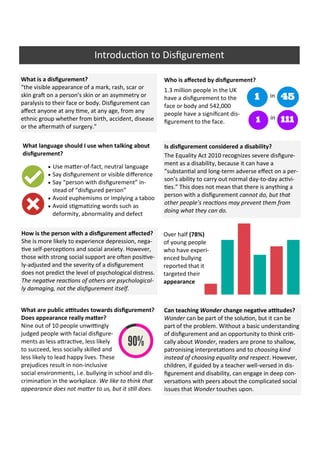
Research review
- 1. What are public attitudes towards disfigurement? Does appearance really matter? Nine out of 10 people unwittingly judged people with facial disfigure- ments as less attractive, less likely to succeed, less socially skilled and less likely to lead happy lives. These prejudices result in non-inclusive social environments, i.e. bullying in school and dis- crimination in the workplace. We like to think that appearance does not matter to us, but it still does. What is a disfigurement? “the visible appearance of a mark, rash, scar or skin graft on a person’s skin or an asymmetry or paralysis to their face or body. Disfigurement can affect anyone at any time, at any age, from any ethnic group whether from birth, accident, disease or the aftermath of surgery.” Use matter-of-fact, neutral language Say disfigurement or visible difference Say “person with disfigurement” in- stead of “disfigured person” Avoid euphemisms or implying a taboo Avoid stigmatizing words such as deformity, abnormality and defect Is disfigurement considered a disability? The Equality Act 2010 recognizes severe disfigure- ment as a disability, because it can have a “substantial and long-term adverse effect on a per- son’s ability to carry out normal day-to-day activi- ties.” This does not mean that there is anything a person with a disfigurement cannot do, but that other people’s reactions may prevent them from doing what they can do. 1.3 million people in the UK have a disfigurement to the face or body and 542,000 people have a significant dis- figurement to the face. How is the person with a disfigurement affected? She is more likely to experience depression, nega- tive self-perceptions and social anxiety. However, those with strong social support are often positive- ly-adjusted and the severity of a disfigurement does not predict the level of psychological distress. The negative reactions of others are psychological- ly damaging, not the disfigurement itself. Can teaching Wonder change negative attitudes? Wonder can be part of the solution, but it can be part of the problem. Without a basic understanding of disfigurement and an opportunity to think criti- cally about Wonder, readers are prone to shallow, patronising interpretations and to choosing kind instead of choosing equality and respect. However, children, if guided by a teacher well-versed in dis- figurement and disability, can engage in deep con- versations with peers about the complicated social issues that Wonder touches upon. Introduction to Disfigurement in in What language should I use when talking about disfigurement? Who is affected by disfigurement? Over half (78%) of young people who have experi- enced bullying reported that it targeted their appearance